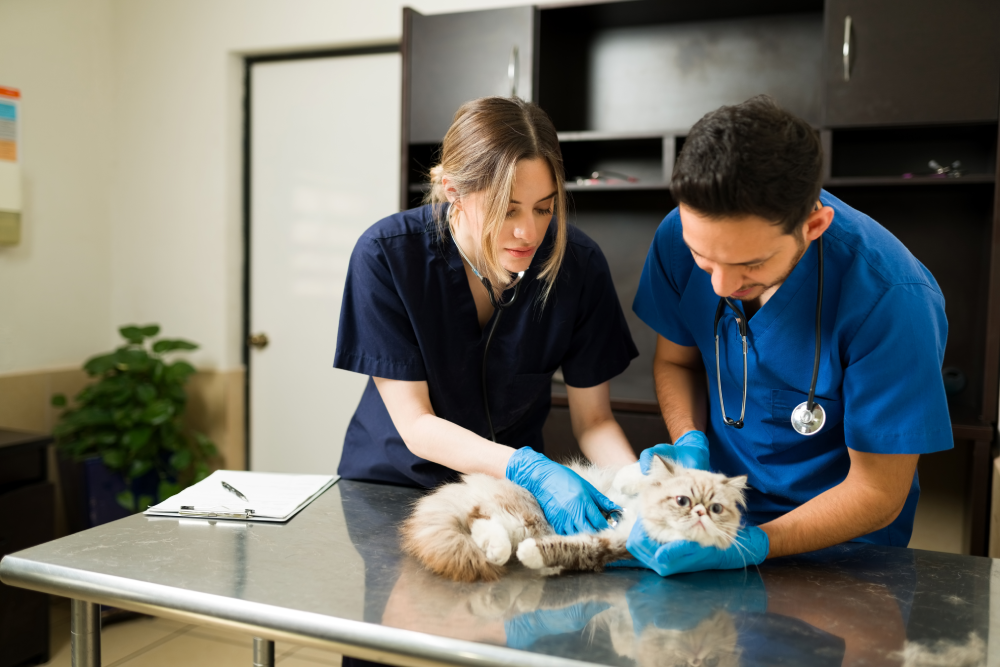Have you ever watched your furry friend struggle to get up, wince when you touch a certain spot, or lose interest in activities they once loved? As pet owners, it’s heartbreaking to see our beloved animals in pain. We want to help them feel better, play without discomfort, and enjoy life to the fullest. That’s where the world of animal chiropractic comes in, offering a drug-free approach to pain management and overall well-being.
Understanding the Basics of Animal Chiropractic
Think of your pet’s spine as the central highway for their nervous system. This intricate network controls everything from movement and digestion to their ability to feel and react to the world around them. When the vertebrae in the spine become misaligned – often referred to as subluxations – it can interfere with the proper flow of information, leading to pain, stiffness, and a whole host of other problems.
A pet chiropractor focuses on identifying and correcting these subluxations through gentle, hands-on adjustments. These adjustments help to restore proper alignment, allowing the nervous system to function optimally. It’s not about cracking bones or forcing movement; it’s about using specific, controlled movements to encourage the body’s natural healing abilities. The goal of a pet chiropractor nearby is to address the root cause of the problem, rather than just masking the symptoms with medication. This approach supports the body’s innate ability to heal itself, leading to long-term relief and improved quality of life for your animal companion. Finding a qualified pet chiropractor is key to ensuring your pet receives safe and effective care.
Conditions That May Benefit from Chiropractic Care
You might be wondering what kinds of conditions can benefit from seeing a pet chiropractor. The answer might surprise you. While it’s commonly associated with back pain and stiffness, animal chiropractic can be helpful for a wide range of issues.
- Musculoskeletal Problems: This includes things like arthritis, hip dysplasia, disc disease, and lameness. If your dog is slowing down on walks, having trouble jumping, or showing signs of discomfort when getting up or down, chiropractic care could offer relief.
- Nervous System Issues: Seizures, nerve damage, and even some behavioral problems can sometimes be linked to spinal misalignments. By restoring proper nerve function, a pet chiropractor may help to improve these conditions.
- Performance Enhancement: For athletic animals, such as agility dogs or racehorses, chiropractic care can help optimize performance by ensuring proper joint movement, balance, and coordination. Regular adjustments can help prevent injuries and keep them in top condition.
- Post-Surgical Rehabilitation: Chiropractic can be a valuable part of the recovery process after surgery, helping to restore mobility, reduce pain, and promote healing.
- General Wellness: Even if your pet doesn’t have a specific health problem, regular chiropractic checkups can help maintain their overall health and well-being, just like regular checkups with your family doctor.
What to Expect During a Chiropractic Session
If you’re considering taking your pet to a chiropractor, you’re probably curious about what to expect during a typical session. The first visit will usually involve a thorough consultation and examination. The pet chiropractor will want to know about your pet’s history, including any past injuries, surgeries, or health problems. They will also observe your pet’s posture, gait, and range of motion. Palpation, or feeling the spine and surrounding tissues, is a key part of the exam, allowing the chiropractor to identify areas of restriction or tenderness.
Once the examination is complete, the chiropractor will develop a treatment plan tailored to your pet’s specific needs. Adjustments are typically performed by hand, using gentle, controlled movements to restore proper alignment to the spine and other joints. Many animals find these adjustments to be quite relaxing, and some may even fall asleep during the session. The number of treatments needed will vary depending on the individual animal and the condition being treated. Some pets may experience significant improvement after just a few sessions, while others may require ongoing maintenance care.
The Drug-Free Advantage
One of the biggest appeals of animal chiropractic is that it offers a drug-free approach to pain management. While medications can be effective at masking pain, they often come with unwanted side effects, such as drowsiness, digestive upset, and liver damage. Chiropractic care, on the other hand, addresses the underlying cause of the pain without the use of drugs. This can be especially beneficial for pets who are sensitive to medications or who have chronic conditions that require long-term pain management.
By restoring proper alignment and nerve function, chiropractic care can help reduce inflammation, relieve muscle tension, and promote the release of endorphins, the body’s natural painkillers. This can lead to a significant reduction in pain and an improvement in overall comfort and quality of life for your pet.
Finding a Qualified Animal Chiropractor
It’s important to note that not all chiropractors are trained to work on animals. Animal chiropractic requires specialized knowledge and skills, and it’s essential to find a practitioner who has the proper training and credentials. Look for a chiropractor who is certified by a reputable organization, such as the American Veterinary Chiropractic Association (AVCA) or the International Veterinary Chiropractic Association (IVCA). These organizations require practitioners to complete extensive post-graduate training in animal chiropractic and to pass rigorous certification exams.
You can also ask your veterinarian for a referral to a qualified animal chiropractor. Your vet can help you determine if chiropractic care is appropriate for your pet’s condition and can work with the chiropractor to develop a comprehensive treatment plan.
Complementary Therapies
Animal chiropractic often works well in conjunction with other therapies, such as acupuncture, massage, and physical therapy. These therapies can help to further reduce pain, improve mobility, and promote healing. For example, acupuncture can help to stimulate the release of endorphins and reduce inflammation, while massage can help to relax muscles and improve circulation. Physical therapy can help to strengthen muscles, improve balance, and restore proper movement patterns. Your pet chiropractor at K. Vet Animal Care can advise you on which therapies may be most beneficial for your pet and can work with other practitioners to coordinate their care.
K. Vet Animal Care: Your Partner in Pet Wellness
At K. Vet Animal Care, located at 1 Gibralter Way in Greensburg, PA, we understand that your pet’s health and well-being are your top priorities. That’s why we’re proud to offer animal chiropractic as part of our comprehensive approach to veterinary care. Our experienced team is dedicated to providing compassionate, individualized care to help your pet live a happy, healthy, and active life. We believe that chiropractic care can be a valuable tool for managing pain, improving mobility, and enhancing overall wellness in animals of all ages and breeds.
We take the time to listen to your concerns, thoroughly examine your pet, and develop a treatment plan that’s tailored to their specific needs. Our goal is to help your pet feel their best, so they can enjoy all the things they love to do.
Observing Positive Changes
One of the most rewarding aspects of animal chiropractic is seeing the positive changes it can bring to the lives of our patients. Owners often report that their pets are more energetic, playful, and comfortable after receiving chiropractic care. They may notice that their pets are moving more freely, sleeping better, and showing less signs of pain or stiffness. For some animals, the improvements can be dramatic, allowing them to return to activities they had previously given up due to pain or discomfort.
It’s important to remember that chiropractic care is not a quick fix. It’s a process that requires time, patience, and commitment. However, the benefits can be well worth the effort. By addressing the underlying cause of the problem and supporting the body’s natural healing abilities, chiropractic care can help your pet live a longer, healthier, and more fulfilling life.
The team at K. Vet Animal Care, serving Greensburg, PA, wants to empower pet owners to make informed decisions about their animal’s health. Exploring drug-free pain management options such as consulting a pet chiropractor, is a great first step towards ensuring your furry friend lives their best life. We believe in a collaborative approach, working closely with you to develop a plan that aligns with your pet’s needs and your goals for their well-being.
Frequently Asked Questions
Q: Is animal chiropractic safe?
A: When performed by a qualified and experienced practitioner, animal chiropractic is generally considered to be very safe. The adjustments are gentle and controlled, and the risk of injury is low.
Q: What types of animals can benefit from chiropractic care?
A: Chiropractic care can be beneficial for a wide variety of animals, including dogs, cats, horses, and even rabbits.
Q: How many chiropractic sessions will my pet need?
A: The number of sessions needed will vary depending on the individual animal and the condition being treated. Some pets may experience significant improvement after just a few sessions, while others may require ongoing maintenance care.
Q: How do I know if my pet needs to see a chiropractor?
A: If your pet is showing signs of pain, stiffness, or decreased mobility, it’s worth considering a chiropractic evaluation. Other signs that may indicate a need for chiropractic care include changes in posture, gait, or behavior.
Q: Will my vet approve of chiropractic care?
A: Many veterinarians are supportive of chiropractic care as a complementary therapy. It’s always a good idea to discuss your plans with your vet to ensure that chiropractic care is appropriate for your pet’s condition.
Q: How do I find a qualified animal chiropractor?
A: Look for a chiropractor who is certified by a reputable organization, such as the American Veterinary Chiropractic Association (AVCA) or the International Veterinary Chiropractic Association (IVCA). You can also ask your veterinarian for a referral.
Q: What does a chiropractic adjustment feel like to the animal?
A: Most animals find chiropractic adjustments to be quite relaxing. Some may even fall asleep during the session. The adjustments are gentle and controlled, and should not cause any pain.
Q: How much does animal chiropractic cost?
A: The cost of animal chiropractic can vary depending on the location and the practitioner. It’s best to contact the chiropractor directly to inquire about their fees.
Q: Is there anything I should do to prepare my pet for a chiropractic session?
A: It’s helpful to bring your pet’s medical history with you to the appointment. You should also avoid feeding your pet a large meal before the session.
Q: What should I expect after a chiropractic session?
A: Some pets may experience mild soreness or stiffness after a chiropractic session, but this usually resolves within 24-48 hours. Many pets feel immediate relief and are more comfortable and mobile after their adjustment.
By understanding the principles and benefits of animal chiropractic, you can make informed decisions about your pet’s health and well-being. If you’re looking for a drug-free approach to pain management, chiropractic care may be the answer you’ve been searching for.
K. Vet Animal Care
1 Gibralter Way, Greensburg, PA 15601, United States
(724) 216-5174

